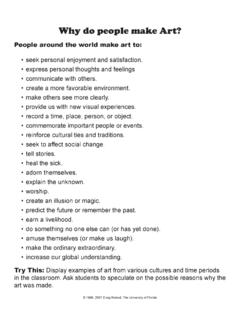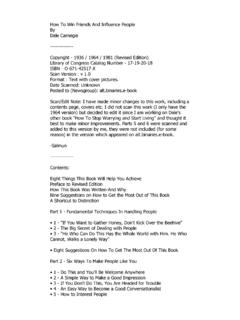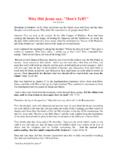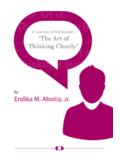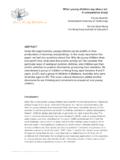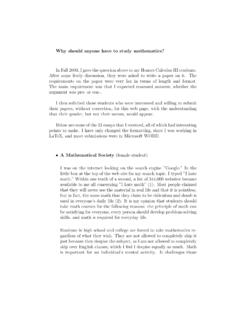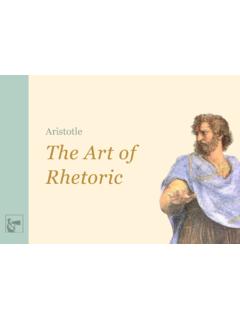Transcription of The Art Of Self Discovery - happinesscounseling.com
1 BY THE BESTSELLING AUTHOR OF HONORING THE self AND. HOW TO RAISE YOUR self -ESTEEM. NATHANIEL. BRANDEN. THE ART. OF self - Discovery A POWERFUL. TECHNIQUE. FOR BUILDING. self -ESTEEM. Previously titled TO SEE WHAT I SEE AND KNOW WHAT I KNOW THE ART OF self - Discovery . A Bantam Book PUBLISHING HISTORY. Published as a trade paperback by Bantam Books in January 1986 under the title To See What I See And To Know What I Know Bantam paperback edition/October 1993. Copyright 1985 by Nathaniel Branden. Revised edition copyright 1993 by Nathaniel Branden. Library of Congress Catalog Card Number: 85-47792. ISBN 0-553-29753-8. Published simultaneously in the United States and Canada [NOTE FOR THIS DIGITAL VERSION: Because this book unfortunately has been relegated to the realm of out-of-print books by its publisher (readers might find used versions online, , on ), this digital format was created in 2012 so that these psychological memes can continue to spread far and wide.]
2 Many thanks to Nathaniel Branden for all his helpful work and for making this book a reality.]. ACKNOWLEDGMENTS. Many thanks to my Bantam editor, Linda Cunningham, whose helpful suggestions and criticisms are a deeply appreciated contribution. Thanks to my agent, Gerard McCauley, whose counsel and friendship through many, many years have made our relationship unfailingly rewarding. And finally, once again, my love and thanks to my wife, Devers, who remains my best friend and toughest critic. Contents Introduction 1 ~ The Power of Sentence Completion 2 ~ Guidelines for Sentence Completion Work 3 ~ Introductory Exercises 4 ~ Exploring the Influence of Our Parents 5 ~ Our Child- and Teenage-Selves 6 ~ Exploring "Negative" Feelings and Emotions 7 ~ Exploring "Positive" Feelings and Emotions 8 ~ Exploring Sexuality 9 ~ self -Esteem 10 ~ The Sage- self CONCLUSION: Continuing the Journey Toward self - Discovery APPENDIX: Recommendations for Further Study Introduction The ideal of self -understanding is at least as old as the great age of Classical Greece evidenced by the injunction "Know thyself" and the statement "The unexamined life is not worth living.
3 " Thoughtful men and women of all times and places have known or intuited that the self is a vast continent, filled with mystery and possibilities for adventure, and eminently as worthy of exploration as the external world. "Who am I?" remains the ultimate question of human existence, and it is a question we are continually challenged to answer anew, as we go on evolving. We are the only species able to ask such a question; the only species able to ponder our own experience and its possible meaning. We ask: "Where am I. going and why?" "What do I want and why?" "What does it imply about me that I feel what I feel or that I do what I do?" We are beings who are able to think and, most extraordinary of all, to think about ourselves, to question our thoughts, feelings, and behavior. So that, as our life advances, we are able to answer the question "Who am I?" on deeper and deeper levels. Such, at least, is our potential. But it is an option we can adopt only by choice.
4 We are not compelled to think about ourselves or about anything else. We can move through our existence like sleepwalkers and this, tragically, is just how much of humanity chooses to live. The result is a chronic condition of self - estrangement and self -alienation. We are chronically lonely for ourselves. We remain a person we have not chosen to meet. But in the second half of this century, particularly in the United States, more and more people appear to be finding this state of a airs unacceptable. Witness the explosion of interest in the field of psychology; the proliferation of books promising self -illumination; the seminars and workshops aimed at one form or another of self -realization; to say nothing of the increasing numbers of people seeking psychotherapy, not, as a rule, because they are more troubled than the rest of the population, but because they are more motivated to become actively involved in the process of their own growth. In my experience, many of the people who enter therapy come not so much because of any specific complaints they might mention at the first interview, but with the hope that they will become more intelligible to themselves, more in touch with the sources of their own behavior in other words, the age-old longing for self -understanding.
5 Not that self -understanding by itself guarantees successful growth or change. It doesn't. In fact, modern psychotherapy has discarded the belief that understanding by itself is enough. For genuine change and growth, action is needed. But, often, self -understanding is the first step. And beyond that, self -understanding can be intrinsically rewarding. It can be a source of pleasure. It satisfies our hunger for intelligibility. As such, the experience of self -understanding can be integrative, can bring us closer to the experience of wholeness. And that experience is life-serving. Sometimes we seek self -understanding with an eye to highly practical and immediate goals: we wish to be more e ective in our relationships or more successful in our work, and we want to know if and how we might be standing in our own way. If we find that we do engage in self -sabotaging behavior, we want to know why (for what purpose) and how we can go about changing. There is still another benefit we can derive from self -knowledge: an enhanced understanding of others.
6 If "How am I to understand myself?" is one of the two most painful questions people struggle with through their lives (with varying degrees of awareness), the other is: "How am I to understand other people?". The two questions are connected. If we are a mystery to ourselves, we tend to find other people a mystery. On the other hand, people who are in reasonably good contact with themselves seem to find others more comprehensible. We need self -awareness and self -knowledge to understand the feelings and behavior of others. For example, in order to be a competent parent and to understand the emotions and needs of a child, we must be in contact with the child within us, the child we once were. If the child within is a stranger to us, so will be any child we may encounter. If we are alienated from our own capacity for love, or our own need for love, we will not understand the emotion of love in another. If we are cut o from our own excitement, the excitement of others will bewilder or annoy us.
7 Whether our desire for greater self -knowledge is abstract and general, or urgently specific and immediate, the question is: How can we go about attaining such knowledge? This brings me to the purpose of this book. My aim is to o er the reader a method of self -understanding with a potential of incalculable power: the sentence-completion technique. I first developed this technique in the context of psychotherapy, as a tool to facilitate self - Discovery , self -expression, and self -healing. To that end, I worked with it not only in individual and group therapy but also in seminars and workshops, attended by many thousands of people who found they could master the fundamentals of the method rather quickly even though quite a few started out convinced it was beyond them. Soon it became apparent that men and women, after they had grasped the essentials of the method, could take the technique home and use it on their own, sometimes in very imaginative and creative ways.
8 Later, I began thinking about how I could teach the method to people I would never encounter personally. "If You Could Hear What I Cannot Say" was my first workbook aimed specifically at teaching readers how they could use sentence completion at home to solve problems in communication with the ones they love. In it, I describe an incident that occurred when I first wrote about my use of the sentence-completion technique in The Disowned self . I was halfway through the writing of the book when my editor telephoned me. "Nathaniel," she asked, "in the sections where you recreate dialogue and events from therapy, how much editing of the original transcripts do you do?". "Not much. Sometimes I clean up the grammar a little or eliminate irrelevant digressions. I reword sentences where the original contains references that the reader wouldn't be able to make sense of. And, of course, I change details that might disclose the client's identity. Why do you ask?". "It's those sections containing transcripts of sentence-completion work that have me a bit concerned.
9 It all moves so swiftly; people seem to get down to their feelings and motivations so fast. Will anyone believe it? Will anyone believe it really happens that way?" "I don't know what to say. Why don't you sit in on one of my therapy sessions and see for yourself how the method works. Then you tell me if you think I am faithfully reporting what happens.". The following week she came to one of my group therapy sessions. Needless to say, some days the work goes smoothly, other days there are di culties and nothing seems to go right. I couldn't even be certain in advance that a problem would arise on this particular day for which sentence completion would be appropriate. As it happened, one problem after another was presented that seemed right for sentence completion, and everyone's work moved with electrifying speed. The experience was gratifying for me as well as for my clients, but it was not especially unusual. After the clients had gone, my editor smiled and shrugged.
10 "There's nothing to be done. The way you describe it is the way it happens. But it is incredible when you think of people lying on couches year after year to gain the kinds of insights that emerge here in minutes.". As I have already indicated, my concern in The Art of self - Discovery is more global: sentence completion as a tool of personal exploration, a means of voyaging into the self . Let us consider some of the kinds of self -understanding we might achieve through the exercises in this book. Do you know what situations trigger anger in you, and what you typically do in those situations, and by what means you sometimes try to conceal your anger, and in what disguised form your anger comes out? Do you know what circumstances stimulate feelings of happiness in you, and what you sometimes do when you are happy, and by what means you sometimes try to conceal your happiness, and why you might feel driven to conceal it? Do you know how you sometimes sabotage your chances for fulfillment in love, and why you may do so?
